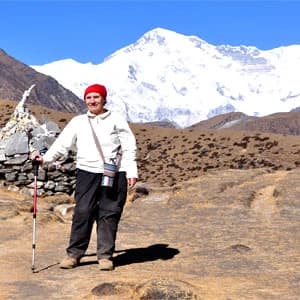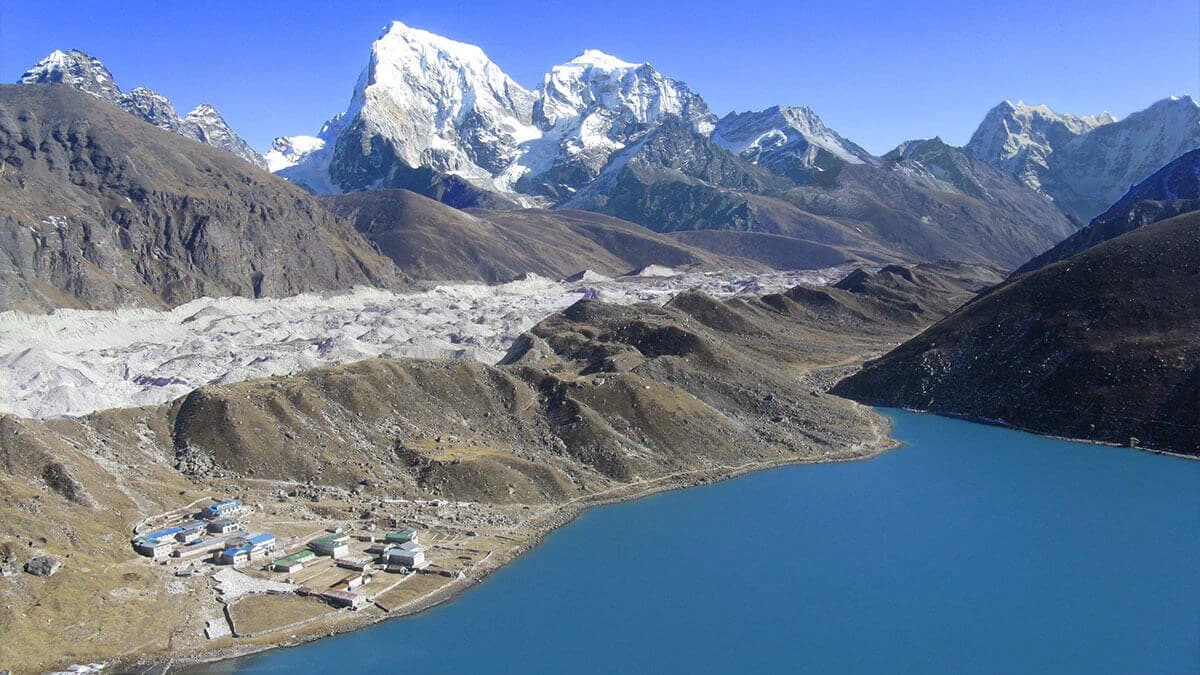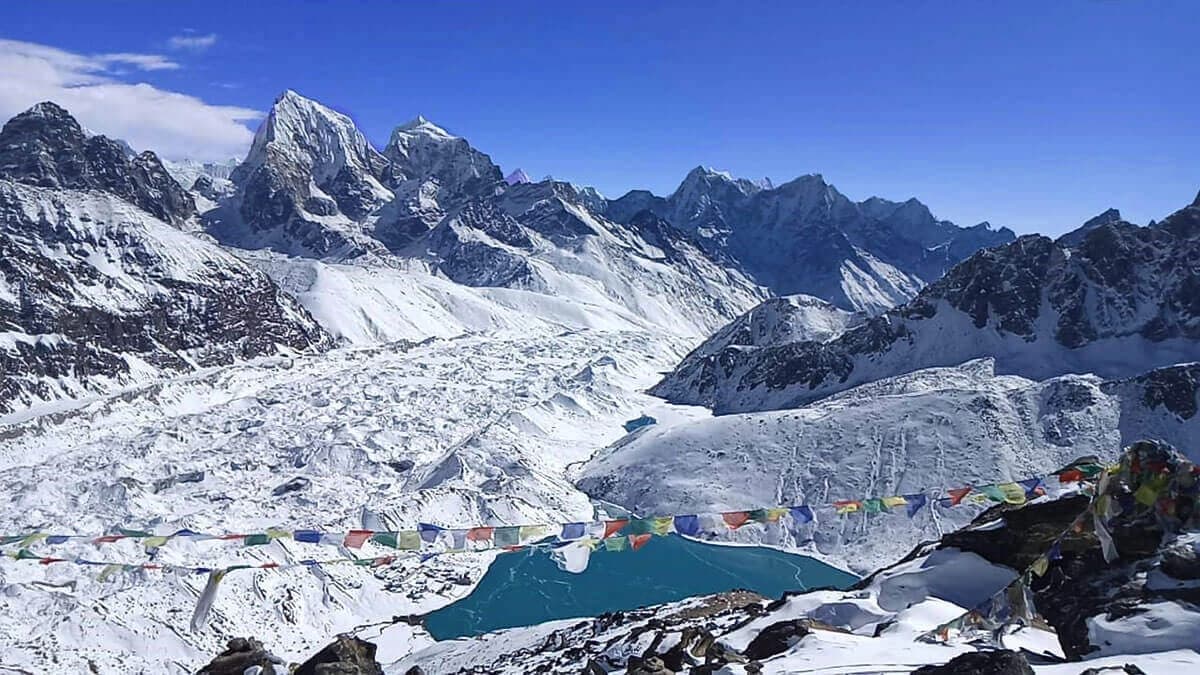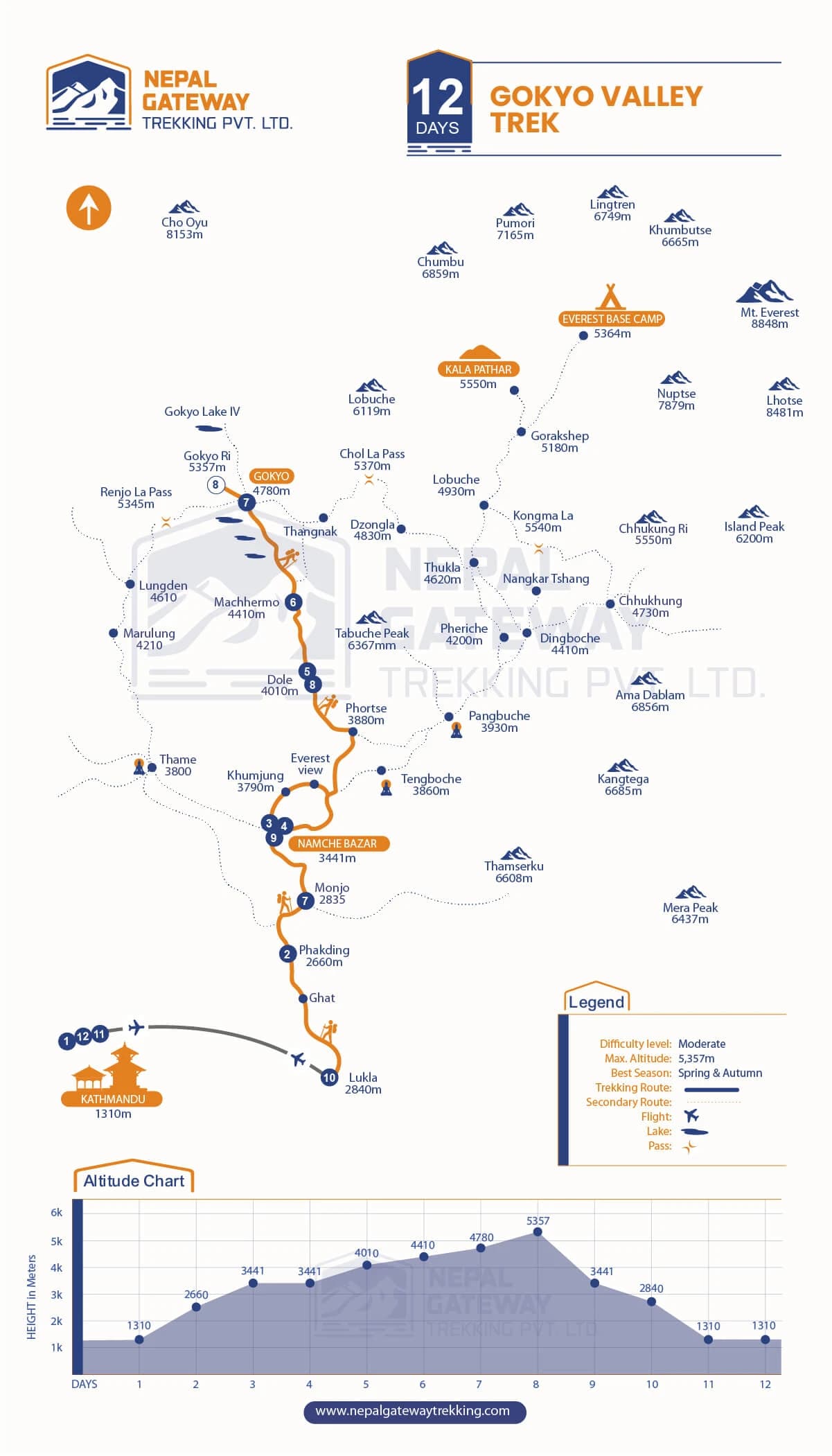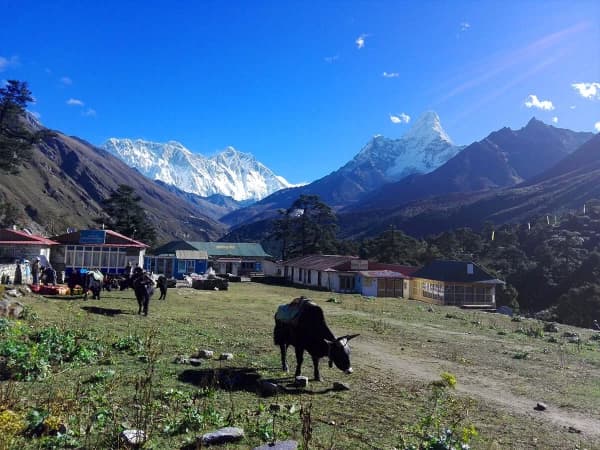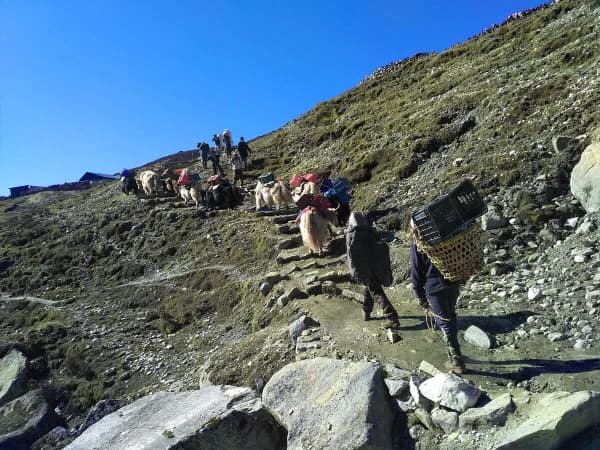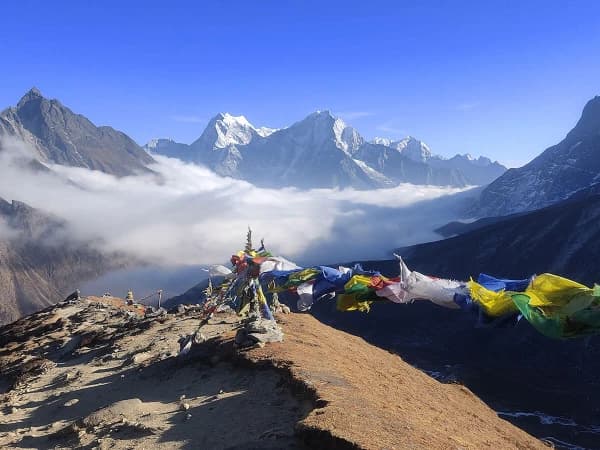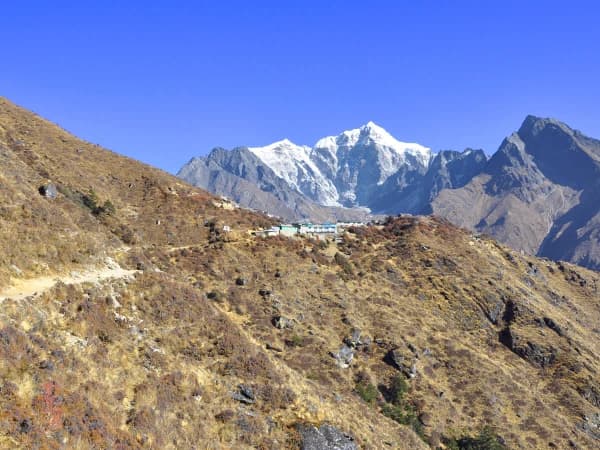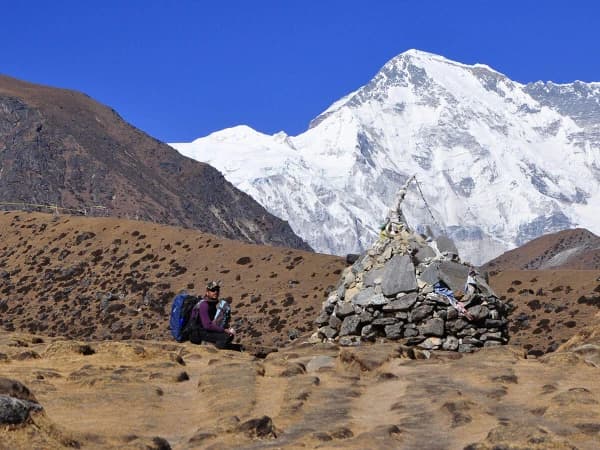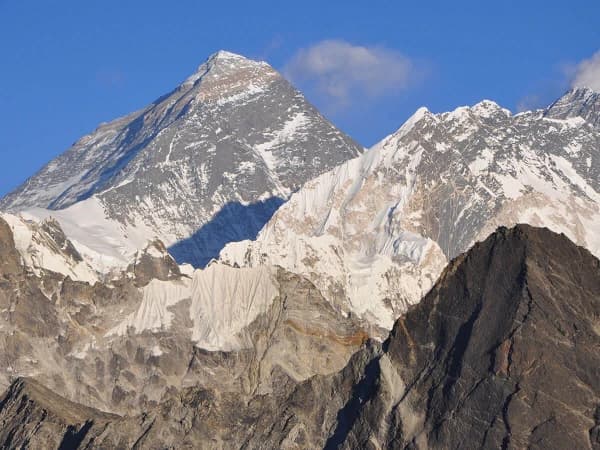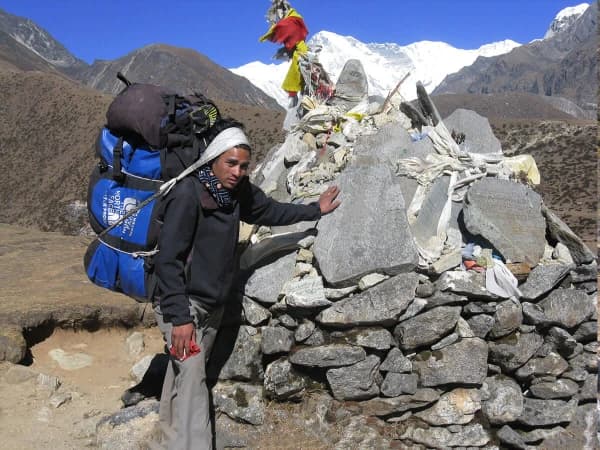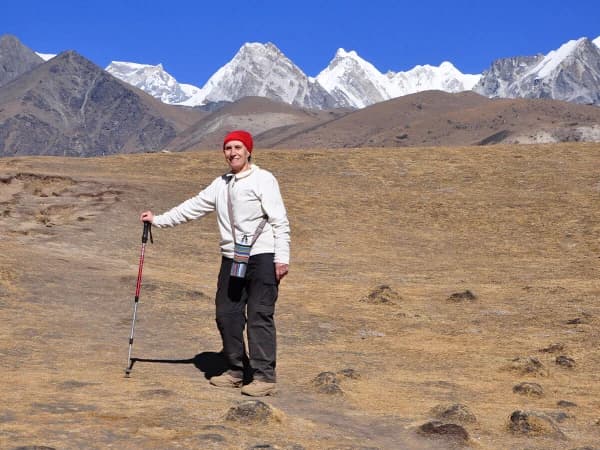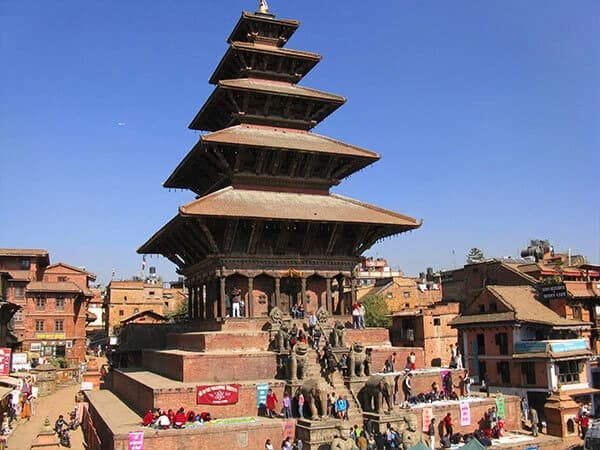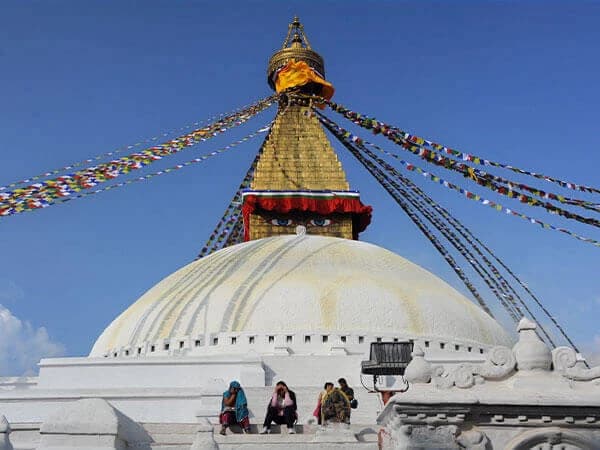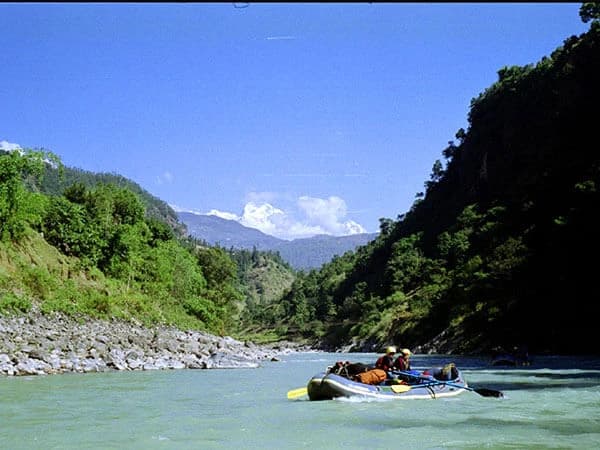Are you interested in trekking to a pristine lake at 5,000 meters, surrounded by stunning views of towering, snow-capped peaks over 8,000 meters? The Gokyo Valley Trek makes your dream a reality.
Gokyo Valley Trek
Gokyo Valley Trek is one of the most spectacular walks in the high Himalayas of the Everest region. It provides the perfect blend of mountain scenery, cultural encounters, Sherpa hospitality, and the tranquility of the Gokyo Lakes.
The trek to Gokyo Valley is an excellent alternative to the classic Everest Base Camp Trek, as the trails are much quieter and pristine. Moreover, it takes you across some of the most significant landmarks in the Khumbu region, including Namche Bazaar, Gokyo Valley, and Gokyo Ri.
Gokyo Ri, at 5,357 meters, marks the highest point of this trek. It offers a breathtaking view of Mt. Everest, Lhotse, Cho Oyu, and Makalu. From its summit, you can also glimpse the aerial view of Gokyo Lakes and Ngozumpa Glacier.
Important Note: During the peak season, flights will be operated from Manthali Airport, Ramechhap, to Lukla. In the spring, from mid-March to mid-May and late September to November in autumn, all flights take off and land at Manthali Airport.
The Manthali airport, Ramechhap, is 142 km from Kathmandu, a 4-5 hour drive. To catch a flight to Lukla from Ramechhap, you must depart from Kathmandu from 1 a.m. to 2 a.m.
We highly recommend that you come with at least one more extra day for jet lag, especially considering the early morning drive to Manthali Airport, which benefits from adequate rest and sleep beforehand.
The Major Highlights of Gokyo Valley Trekking
- Experience one of the most exhilarating flights to Tenzing-Hillary Airport at Lukla.
- Explore the bustling town of Namche Bazaar.
- Hike to Everest View Hotel, one of the world’s highest luxury hotels.
- Stand at the shore of the pristine Gokyo Lakes and soak up the beauty of its iridescent turquoise waters.
- Hike to Gokyo Ri to relish some of the world’s highest mountains, including Mt. Everest, Makalu, Cho-Oyu, and Lhotse.
- Walk across the moraine of the Himalayas' longest glacier—Ngozumpa Glacier.
- Enjoy the quieter trails of the Everest region and witness the remote lifestyle of the Himalayas.
Gokyo Valley Route Overview
Your journey to Gokyo Valley begins with a thrilling 40-minute flight to Tenzing-Hillary Airport in Lukla. Trudging through the Sherpa villages of Phakding, Namche Bazaar, Dole, and Machhermo, you’ll finally arrive at the Gokyo Valley. You’ll hike to the summit of Gokyo Ri and start retracing the route.
In the next few days, you’ll descend to Lukla via Dole and Namche Bazaar. Then, you’ll fly back to Kathmandu to conclude the trek. This trek is regarded as moderate in terms of difficulty. You’ll have to walk regularly on a rough, rugged path for at least 5 to 6 hours. It also possesses a high possibility of altitude sickness.
However, our 12-day Gokyo Valley Trekking itinerary provides a perfect balance of daily ascent and walking distance to ensure enough time for acclimatization. This trek is suitable for all travelers, from first-timers to experienced ones.
Why Everest Gokyo Valley Trek with Nepal Gateway Trekking?
- Our trekking guides are professional and qualified, with over a decade of experience in the Himalayas. They will be accompanied by an experienced team of Sherpas and porters to ensure top-notch management and safety.
- All our guides are certified in Wilderness First Aid (WFA). They will carry an advanced first aid kit to provide emergency assistance.
- The 12-day Gokyo Valley Trek includes a strategically placed acclimatization day at Namche Bazaar for a well-paced trek to ensure maximum success.
- We have handpicked the best teahouses in the region because you deserve the best rooms and meals after a long day of trekking. The package price includes all three meals (breakfast, lunch, and dinner) while on the trek.
- While in Kathmandu, you’ll stay at the Woodapple Hotel and Spa (or similar), conveniently located in Thamel's tourist hub. This is a 3-star category hotel that offers top-notch service and hospitality.
- As soon as you confirm the booking of this trip, we will secure your flights to Lukla. This gives you a better chance of getting the day's first flight.
- Receive a souvenir duffel bag and t-shirt from Nepal Gateway Trekking.
Itinerary
This is our standard and recommended Gokyo Valley Trek Itinerary.
Your adventure holiday starts here! After landing at the Tribhuvan International Airport, an official representative of the Nepal Gateway Trekking will greet you with traditional Nepali hospitality. He will arrange to transfer you to the hotel and assist you with the check-in formalities.
Once you’ve checked in, you can rest and recover from the jetlag. In the evening, you’ll meet your trekking guide in the lobby for a comprehensive briefing about the days ahead. After the session, the guide will thoroughly check your gear and supplies to ensure you’ve packed all the essentials for the trek.
Your guide will arrive at your hotel lobby early in the morning to transfer you to Kathmandu Airport's domestic terminal. The 40-minute flight offers stunning views of the mountains and surrounding landscapes.
Upon landing at Tenzing-Hillary Airport, you’ll meet the rest of the trekking crew. Your trek begins with a gradual walk through Chaurikharka village towards Dudh Koshi Ghat. From here, the rest of the trail passes through the riverbank of Dudh Koshi River until we reach Phakding.
Important Note: During the peak season, flights will be operated from Manthali Airport, Ramechhap, to Lukla. In the spring, from mid-March to mid-May and late September to November in the autumn season, all flights take off and land at Manthali Airport.
The Manthali airport, Ramechhap, is 142 km from Kathmandu, a 4-5 hour drive. To catch a flight to Lukla from Ramechhap, you must depart around 1 a.m. to 2 a.m. from Kathmandu.
After breakfast, you’ll begin the day by crossing a steel suspension bridge over the Dudh Koshi River. You’ll continue the walk on a fairly pleasant trail under the shades of a beautiful pine forest. After two to three hours, you’ll reach the Sagarmatha National Park entrance gate at Monjo.
After a quick permit check, you’ll descend back to the river and head towards the lunch stop at Jorsalle.
After lunch, the trail is uphill until Namche Bazaar. Along the way, you’ll cross two long steel suspension bridges — one being the famous Hillary Bridge. Just halfway into the strenuous climb to Namche Bazaar, you’ll get the first glimpse of Mt. Everest.
On this day, you’ll take a much-needed break to let your body acclimatize to the high altitude. There is plenty to do in Namche Bazaar.
After breakfast, you’ll go for a two-hour hike to the Everest View Hotel — one of the world’s highest luxury hotels. The sundeck area of the hotel offers the finest panoramic view of some of the world’s highest mountains, including Mt. Everest, Nuptse, Ama Dablam, and Thamserku.
On your way back to Namche Bazaar, visit the Sherpa Culture Museum to see the fascinating collection of Sherpa cultural objects and ancient photographs. After that, you can call it a day and rest or visit a nearby monastery in the afternoon.
You’ll start the day with a gentle uphill on the ridge northward of Namche Bazaar. The top offers a spectacular view of Mt. Everest, Lhotse, Nuptse, and Ama Dablam. You’ll follow the main trail of Everest Base Camp Trek until you reach the crossroad village of Kyangjuma.
As you walk a little further from the village, you’ll reach a junction where the trail separates with a steep and dusty climb to Mong La. You’ll gradually descend towards Phortse Tenga under the shades of rhododendrons and birch forests before ascending to Dole for an overnight stay.
Your day begins with a steady climb from the valley of Dole above the treeline. With the increasing altitude, scrub juniper slowly replaces the rhododendron and birch forest, preluding the view of Machhermo Peak to the west and Cholatse to the east.
As the trail continues to climb up the valley, you’ll walk past Lapharma Kharka and Luza Kharka — alpine pastures used to graze yaks in the summer. Here, you’ll be greeted with an excellent view of Cho Oyu. After walking around a small ridge, you’ll arrive at the beautiful valley of Machhermo.
Since the trek is relatively short, you’ll reach Machhermo by lunchtime. By the time you check in to the teahouse, you might start to feel the altitude. So, rest and let your body acclimatize to the increasing altitude.
You’ll begin the day with a gentle climb on a scenic ridge towards Pangka, enjoying the view of Kangtega and Cho Oyu. From here, the trail goes downwards to the river flowing from the Ngozumpa Glacier’s west side.
Following the steep, rugged slope beside the moraine of the Ngozumpa Glacier, you’ll arrive at the first lake of Gokyo. As you walk a few meters further towards the north, you’ll reach the second lake.
The third lake is only a few minutes away from the second lake. The third lake — locally known as Dudh Pokhari — is comparatively larger than the previous two. Continue walking along the trail parallel to the pristine lake until you reach the Gokyo Valley that rests beside the lake.
Spend the evening on the shore of the Gokyo Lake, immersing in the beautiful mountain scenery reflected in its iridescent turquoise waters.
On this day, you’ll wake up early before the first light and hike to the summit of Gokyo Ri. Located 5,357 meters northwest of the valley, Gokyo Ri is often regarded as one of the best Everest viewpoints (many argue it’s better than Kala Patthar!).
The two-hour walk is steep and strenuous, demanding heavy ascent on a rugged trail. Since you’ll be hiking in the dark, bring your headlamps and torches to bear. The top of Gokyo Ri offers a picture-postcard view of some of the world’s highest mountains, including Mt. Everest, Cho Oyu, Lhotse, and Makalu. Additionally, all three lakes of Gokyo are also visible from the summit.
After spending some time at the top, you’ll head back to the teahouse in Gokyo Valley for breakfast. After breakfast, you’ll retrace our route back to Dole to settle in for the night.
From Dole, you’ll head back to Namche Bazaar. The route is the same as you came up for most of this day. You’ll walk past several remote villages, including Phortse Tenga and Mong, before descending rapidly towards the small settlement of Kyangjuma.
From the crossroads, we’ll turn towards Khumjung and Khunde village instead of heading back the same route to Namche Bazaar. Here, you’ll have the opportunity to visit the Khumjung Monastery, Khumjung Secondary School, and Khunde Hospital.
After exploring the two adjoining villages, you’ll make your way back to Namche Bazaar for the night stay.
Your final day in the mountains begins with a steep descent from Namche Bazaar to Jorselle. This section can be challenging for those not used to walking downhill. From here, the trail is fairly gradual on the river bank of Dudh Koshi River.
The last section of the trek involves a gradual climb through dense pine forest until you reach Lukla, where you will conclude your trek.
In the evening, host a farewell party to celebrate your accomplishment with your guide and trekking crew. This is an ideal time to thank them for making your Gokyo Valley Trek a success.
Today, you’ll bid the mountains farewell and take an early morning flight to Kathmandu. Peek out of your window to relish the mountains one last time on this adventure.
Upon arrival at Kathmandu Airport, a representative of Nepal Gateway Trekking will pick you up from the domestic terminal for a hotel transfer. You’ll have a free afternoon in Kathmandu. You can either rest or go for a walk around Thamel.
On this day, one of our team members will drop you off at the departure section of Tribhuvan International Airport. We will schedule the pick-up three and a half hours before your flight time, so keep your bags packed and ready.
Please let us know if you have further plans to extend your stay in Nepal.
Dates & Availability
Private tripCost Includes
- All ground transportation, including airport pick-up/drop-off by private vehicle.
- Two nights’ accommodation at a three-star category hotel in Kathmandu, including breakfast.
- Round-trip trip to/from Lukla by aircraft, including domestic airport taxes.
- Three meals a day (breakfast, lunch, and dinner) are included in the trekking.
- All accommodations common twin-sharing rooms in teahouses during the trek.
- One highly experienced, English-speaking, government-licensed, friendly trekking guide.
- Required porters (1 porter between 2 trekkers). A porter is not included for 1 person.
- Sagarmatha National Park permit and TIMS card.
- Gokyo Valley Trekking Map.
- Nepal Gateway Company T-Shirt.
- Nepal Gateway Company duffel bag for trekking.
- Local fresh fruits as desserts (apples, oranges, pomegranates, etc.).
- First aid kit with oximeter.
- Evacuation assistance.
- Government taxes.
- Office service charge.
Cost Excludes
- Lunches and dinners in Kathmandu.
- Travel Medical Insurance (Compulsory).
- Nepal Visa.
- Your international flight ticket to/from Kathmandu.
- All kinds of hot drinks (tea, coffee, hot water).
- Cold drinks (water/Fanta/Coke) and alcoholic beverages.
- Your personal nature expenses, equipment, and medical kit.
- Hot shower, internet, and phone call unless it is free.
- Charging fees for devices and cameras.
- Dessert (cakes, pies, chocolate pies, etc.).
- Tipping to field staff (tipping is not mandatory but expected).
Good To Know
Gokyo Valley Trek Cost
Several factors affect the cost of the Gokyo Trek, including group size, number of days, accommodation, and the type of services. If you book the standard 12-day itinerary, the package cost is USD 1320.
This standard package includes two-way flight tickets (to and from Lukla), two nights’ accommodation in Kathmandu (a 3-star category hotel), accommodation in local teahouses with meals (twin-sharing basis), necessary permits, guides and porters, ground transportation, and other essentials.
For a more luxurious option, you’ll get premium rooms in the mountains with heated blankets, ensuite bathrooms, full bedding, and fresh meals. Moreover, you can fly to Lukla via a chartered helicopter to avoid the hassle and possible delays of regular flights. In this case, you’ll have to inform us in advance so we can make the necessary arrangements with the helicopter companies.
Similarly, for a budget-friendly option, you can do the Gokyo Valley Trek with a porter-guide (someone who’ll navigate the trekking route and carry your bags). Likewise, if you want to tailor this trip to your preferences, please get in touch with us directly.
Note: Apart from the package cost, carry extra money for additional expenses during the trek.
Detailed Information on Lukla’s Flight
Tenzing-Hillary Airport in Lukla is the primary entry point for locals, trekkers, and climbers in the Everest region. Initially built in 1964 by the Himalayan Trust, the Lukla Airport is regarded as one of the world’s most dangerous airports due to its elevation, location, and short runway.
The airstrip sits on a cliffside at 2,860 meters, with an asphalt runway that is only 527 meters long and 20 meters wide. Even so, it remains extremely busy during the peak trekking seasons, averaging 30 to 40 flights daily.
Kathmandu to Lukla Flight
The most convenient way to reach Lukla on a commercial flight is to fly directly from Kathmandu. The flight between Kathmandu and Lukla is only 40 minutes long. On a clear day, this flight offers an excellent view of the mountains from the Mahalangur, Rolwaling, and Langtang ranges.
Before 2019, this was the most popular way to enter the Everest region. However, commercial flights to Lukla are now operated from Manthali Airport during the trekking season. Hence, direct flights between Kathmandu and Lukla operate on rare occasions.
Usually, the first flight of the day still operates from Kathmandu. Likewise, airlines occasionally require flying their aircraft to Kathmandu to rotate the pilot and crew members and for maintenance. In such cases, direct flights from Kathmandu to Lukla are possible.
Apart from the trekking seasons, all flights to Lukla are operated directly from Kathmandu.
Manthali to Lukla Flight
In recent years, flights to Lukla have been operating from Manthali Airport in Ramechhap during the peak seasons (autumn and spring). This is to avoid frequent delays and cancellations due to traffic congestion at Kathmandu Airport. Manthali Airport is approximately 130 kilometers from Kathmandu and takes around five hours to drive.
Getting there is a bit of a hassle, but it is a more reliable option compared to Kathmandu. Manthali Airport is significantly closer to Lukla, taking only 12 to 15 minutes on a flight. Moreover, it is solely dedicated to operating flights to and from Lukla. This means a large number of flights can take place in a shorter window if the weather is good.
If your trek is scheduled during this time of the year, we will arrange private transportation to drive you from Kathmandu to Manthali Airport. In this case, your trekking guide will pick you up at your hotel at 2 AM. Once you reach Manthali, you’ll catch a flight to Lukla as early as possible.
Helicopter Option
If you want to avoid the hassle of a five-hour drive to Manthali Airport to fly to Lukla, chartering a helicopter is your best alternative. Although this can be expensive, the 45-minute helicopter ride from Kathmandu is the fastest and most luxurious way to get to Lukla.
Helicopters are far more reliable, safe, and comfortable than regular flights. They are also more likely to operate in bad weather, although this is not always guaranteed.
If you decide to take this option in advance, we will make the necessary arrangements with the helicopter company before you arrive in Nepal. You can also change your flight plan from regular flights to a helicopter option instead.
In this case, you’ll have to add an extra amount (to your plane ticket fare) depending on the cost of the helicopter at that particular time. Note that last-minute bookings may not always be guaranteed, as rescue flights have priority over chartered services.
Flight Delays and Cancellations
Tenzing-Hillary Airport in Lukla is notorious among trekkers for frequent flight delays and cancellations. Due to the elevation and airstrip location, the weather conditions and visibility in Lukla can change rapidly.
Although the mornings are often bright and clear, the afternoons bring thick cloud covers and strong tailwinds, making it difficult to fly to this region.
While the weather in Lukla is the primary cause of flight disruption, seasonality contributes significantly to it. Rain clouds make delays and cancellations more frequent during the monsoon season. Likewise, spring brings high winds and hazy skies during the afternoons, resulting in an early airport shutdown.
During peak trekking seasons, Lukla flights are delayed due to high traffic congestion at Tribhuvan International Airport in Kathmandu. For this reason, the flights are operated from Manthali Airport in Ramechhap during peak seasons — March to April and October to November. Although trekkers have to drive 5 hours from Kathmandu to reach Ramechhap, the probability of flying to Lukla is relatively higher from Ramechhap than from Kathmandu.
Despite that, flight delays and cancellations in Lukla are inevitable. Therefore, we recommend adding a buffer day or two to your itinerary.
When is the Best Time to Trek to Gokyo Valley?
Most people will tell you that the best times to trek to Gokyo Valley are Autumn (September to November) and Spring (March to May). To be fair, these seasons offer decent weather with high visibility, moderate temperatures, and low precipitation.
However, this trek is accessible throughout the year, and each season offers something unique to discover.
Autumn (September to November)
Autumn is regarded as the best season to go trekking in Gokyo Valley. At this time of year, the weather finally begins to get warm and dry after the monsoon rain. Moreover, autumn skies are mostly clear, offering incredible mountain scenery.
Compared to other seasons, the chances of flight cancellation in autumn are relatively low, although delays are frequent.
One downside of trekking to Gokyo Valley this time of the year is the crazy crowd. Since autumn has been the most popular season for Gokyo Valley Trek, you’ll have to deal with busy trails and packed lodges.
Spring (March to May)
Spring is another excellent season to go trekking in Gokyo Valley. The weather is mostly fantastic, with warm mornings, sunny afternoons, and extended daylight. You are likely to witness stunning mountain views in the mornings. However, the cloud cover is quite frequent in the late afternoons.
During these months, the trail of Gokyo Valley will be covered in rhododendrons and primroses in full bloom.
Similar to autumn, the trails and teahouses in Gokyo Valley will likely be crowded with tourists. Also, be cautious about the slippery trails, as pre-monsoon precipitation is expected in this region. The good thing is that the showers in spring last only a short time!
Winter (December to February)
The winter season is best known for clear skies and empty trails. However, it also brings cold weather and frequent snowfall.
The midday temperature during winter is tolerable, although it does not get too warm in this part of the world. But, it is likely to drop rapidly once the sun goes down. Moreover, the temperature in the upper reaches of the trek can go as low as -25°C or -13°F. Hence, the risk of altitude sickness, hypothermia, sunburn, and snow blindness is relatively high.
You must prepare well and pack your gear meticulously to trek to Gokyo Valley in winter. If you’re well prepared, trekking in winter can be very rewarding. As mentioned, the trails will be quiet and empty, and very few tourists will likely cross your paths. The skies are often clear throughout the day, offering spectacular mountain views. In the peak winter, you will have the opportunity to witness the completely frozen Gokyo lakes.
Monsoon (June to August)
Monsoon is the least favorite season for trekking in Gokyo Valley. It is almost guaranteed to rain every single day this time of the year. Although most mornings start with bright and clear skies, the weather changes dramatically by afternoon with thick cloud covers and rain.
Having said that, the colorful spectacle of flower blooms in the upper reaches of this region is a rare sight. During this time of the year, you’ll see different types of flowers throughout the trails in full bloom, including rhododendrons, blue poppies, white edelweisses, and yellow cinquefoils.
However, if you want to trek to Gokyo Valley during the monsoon, you must be extra cautious. You’ll have to be prepared for constant rainfall and slippery tracks.
What Permits are required for Trekking to Gokyo Valley?
You only require two permits to trekking to Gokyo Valley — Khumbu Pasang Lhamu Rural Municipality Permit and Sagarmatha National Park Permit.
1. Khumbu Pasang Lhamu Rural Municipality Permit
The Khumbu Pasang Lhamu Rural Municipality Permit is an essential trekking permit imposed by the local government of the Khumbu region, replacing the TIMS Card.
The cost of this permit is Rs. 3000 for all international travelers. Since this trekking permit is limited within the Khumbu region, you can only obtain it from the checkpoint at Lukla or Monjo. You can not acquire this permit in Kathmandu.
2. Sagarmatha National Park Permit
You also need to obtain the park entry permit — Sagarmatha National Park Permit — to enter the protected areas of the Khumbu region.
The park entry permit costs Rs. 1500 for SAARC nationals and Rs. 3000 for foreign travelers. You can get this permit either from the Nepal Tourism Board office in Bhrikutimandap, Kathmandu or from the entrance gate of Sagarmatha National Park at Monjo.
How difficult is Trekking to Gokyo Valley?
Compared to treks like Everest Three High Passes and Gokyo Lake with EBC, Trekking to Gokyo Valley is a moderate walk in the heart of the Khumbu region. There are no high passes or technical sections along the route of Gokyo Valley. Moreover, most of the trails in this region are well-marked with occasional sign boards and route markers.
Having said that, trekking to Gokyo Valley is no walk in the park.
Since the highest elevation point of Gokyo Valley Trek is 5,357 meters, the risk of altitude sickness is significantly higher. So, walk at the most comfortable pace for your body and drink as much fluids as possible, especially on the upper reaches of the trek.
Our 12-day itinerary is rigorously designed with proper elevation gains and walking distance each day to help you with better acclimatization.
Moreover, you’ll have to walk through rough terrains with steep uphills and downhills for 5 to 8 hours every day. Some of these sections will likely test your physical endurance and mental resilience. Therefore, you need to have a decent level of physical fitness to complete this trek comfortably.
Training for Gokyo Valley Trekking
Although Gokyo Valley Trekking is rated moderately challenging, it requires proper preparation, physical endurance, stamina, and mental resilience.
If you’ve already signed up or are looking forward to signing up for this trek, it is a good idea to start a basic training program to help your body overcome the physical and mental challenges you may face during the trek. For a better result, we recommend you start the training program at least 8 to 12 weeks before the trek.
Go For A Hike
The best way to train for the Gokyo Valley Trek is to take short hikes around your hometown. Find a hiking trail with similar terrain and hike at least once a week. Make a habit of walking at least 6 to 8 hours on the trail to build endurance and stability.
If possible, wear your hiking boots and carry your daypack on your hike to get used to similar conditions.
Cardio Workout
Your average elevation gain during this trek will be around 300 to 400 meters daily. Moreover, you’ll be climbing up to 5,357 meters at Gokyo Ri. So, cardio workouts will train your body to work more with less oxygen and improve your breathing.
Our favourite cardio exercises include jogging, running, swimming, cycling, and jumping ropes. Start slow and increase the frequency of your workout gradually to at least 3 to 4 days a week.
Gym Workout
Another great way to train for the Gokyo Valley Hike is to work in the gym. Admittedly, many trekkers find the idea of going to the gym a bit odd. However, gym workouts can be highly beneficial for building body strength, overcoming pain, and making the trek more comfortable.
Here’s a simple gym training program:
- Jump Squats - 15 to 20 repetitions
- Stairmaster for 20 minutes
- Kettlebell Deadlifts - 5 to 6 repetitions
- Glute Bridge & Hamstring Curl - 10 to 15 repetitions
- Side Plank with Leg Raise - 10 to 15 repetitions on each side
- Step-Ups - 15 to 20 repetitions on each leg
- Downhill Lunges - 15 to 20 repetitions on each leg
Stretching Exercises
Many trekkers often neglect stretching exercises. But the truth is these exercises are quite effective in providing your body with a great range of flexibility and preventing physical injuries. Unlike other exercises, stretching is usually simple, quick, and will not cost you a penny!
Some of the best stretching exercises before trekking are:
- Shoulder Rolls
- Hamstring Stretch
- Calf Stretch
- Standing Quad Stretch
- Wrist Stretch
Some of the best stretching exercises after trekking are:
- Ankle Stretch
- Runner’s Lunge
- Standing Saddle Stretch
- Rag Doll Pose
Acclimatization and Safety
During this trek, you will spend at least four nights above 3,500 meters and hiking up to 5,357 meters at Gokyo Ri. At such elevation, the oxygen and air pressure level drops significantly, increasing the risk of high-altitude sickness.
One way to prevent high-altitude sickness while trekking in the higher stretches of Gokyo Valley is by letting your body acclimatize to the thin air. Simply put, acclimatization is the process of preparing your body to adapt to a new climate or conditions.
Things You Should Do for Acclimatization
- The best approach to acclimatization is to walk at a slow and comfortable pace, letting your body adjust to changing conditions naturally.
- Once you’re above 3,000 meters, a general rule of thumb for daily altitude gain is 400 to 500 meters.
- While ascending to the higher elevation, take a rest day every 3 to 4 days.
- Drink at least 3 to 4 liters of fluid daily while on the road. It’s much better if you reach this feat with only water. But this can also come in the form of hot drinks and soups.
- It is quite common to lose appetite at higher elevations. So, make sure you consume enough nutrients and calories to fuel your body.
- Make sure you pack warm clothes for the trek. Carry a windstopper or fleece jacket in your day pack to protect your body from the harsh wind.
- Carry acetazolamide (Diamox) in your first aid bag for preventive use. However, we recommend you use this medication only if absolutely necessary.
Things You Should Not Do for Acclimatization
- It is best to stay away from alcohol or other stimulants while on the trek.
- Do not sleep during the day, especially on short trekking days. Instead, keep yourself active with short afternoon walks or play some board games.
- If you feel like you have any symptoms of altitude sickness, do not continue the ascent. Communicate immediately with your trek leader or guide so they can assess the situation professionally.
- Due to the change in oxygen level, trekkers can often experience difficulty sleeping. Having said that, you should never take sleeping tablets to fall asleep in the mountains.
How Do We Help Our Clients Acclimatize?
Nepal Gateway Trekking prioritizes the safety and security of our clients on every travel and expedition. Therefore, we have considered several factors to ensure that all our clients acclimate properly while trekking to Gokyo Valley.
Firstly, the 12-day itinerary of the Gokyo Valley Trek includes a strategically planned acclimatization day at an elevation of 3,440 meters at Namche Bazaar. On this day, you will go for a short hike to 3,880 meters at Everest View Hotel and return to Namche Bazaar for an overnight stay. This acclimatization hike helps your body adapt to a higher altitude and prepares you for the rest of the trek.
Secondly, once we cross the 3,000-meter mark at Namche Bazaar, we do not ascend more than 500 meters. While this may not always be possible in the remote parts of Nepal, we consider it whenever possible.
Likewise, our trekking leaders and guides are professionally trained for high-altitude expeditions. They will monitor the oxygen saturation level of your body and your overall health condition every day on the trek. The guides will also carry a first-aid box with all kinds of medications, including acetazolamide (Diamox), to help accelerate your acclimatization if necessary.
Furthermore, if your health condition does not improve even after taking all the necessary precautions, we will arrange an immediate helicopter evacuation and fly you to the hospital in Kathmandu.
Accommodations
In Kathmandu, you will have a comfortable stay at Woodapple Hotel and Spa (or similar) in Thamel. This 3-star category hotel offers a wide range of first-class facilities, including a spa and wellness center, luxurious rooms, and a rooftop restaurant.
While on the trek, you will stay in local teahouses on a twin-sharing basis for 11 nights. Most local lodges in Gokyo Valley Trek are well-maintained, friendly, and atmospheric, with basic amenities. The bedrooms are simple, cozy, and comfortable, consisting of wooden beds, foam mattresses, pillows, and warm blankets.
The dining area is usually the busiest and most decorated room in the teahouses. It is heated during the evenings, and most travelers use it for relaxation and meals. In addition, most teahouses have shared toilets and bathrooms outside the room.
Meals
Unlike other trekking regions, you do not have to compromise much regarding food in Gokyo Valley Trek. The teahouse and restaurants offer a variety of options, from local cuisines like dal bhat, momo, chowmein, and thukpa to continental dishes like pizza, spaghetti, steak, and sandwiches. With a growing number of vegetarians, teahouses and restaurants in the Everest region also serve a decent variety of vegetarian meals.
Besides that, they offer tons of choices when it comes to beverages. You will likely find milk tea, black tea, ginger tea, black coffee, hot juice, hot lemon, and hot chocolate everywhere. A few cafes and hotels also serve machine-brewed coffee, such as Espresso, Cappuccino, Americano, and Cafe Latte.
The hotels and restaurants also serve different alcoholic beverages, but we do not recommend drinking any during the trek. After the trek is completed, you may grab a bottle of beer or two in Namche Bazar or Lukla.
Note: The package price includes all meals on the trek (breakfast, lunch, and dinner).
Drinking Water
While trekking, you will likely lose a lot of fluid from the body in the form of urine and sweat. Therefore, drinking water is one of the most crucial substances for survival in the mountains.
The teahouses in Gokyo Valley offer both tap water and boiled water. Tap water is usually free in this region, but you should never drink untreated water directly from the taps. We highly recommend using purifying tablets to treat the water before drinking it.
The safest option is to drink boiled water. Not only is it safe from water-borne diseases, but boiled water also helps with blood circulation, sore throat, and digestion. Drinking water is commonly supplied by filling individual bottles. So, please carry a water bottle and refill it as needed.
Hot Shower
Hot showers are available in almost every teahouse in Gokyo Trek. However, most teahouses charge a few dollars for a hot shower.
The teahouses in the lower section of the trek provide gas, electric, or solar-powered hot showers. Compared to the upper section, a hot shower is relatively cheap, costing $2 to $3. Some may even include hot showers in the room price.
However, most teahouses in the upper section of the trek do not provide running hot water. It means you’ll have to settle with bucket showers in some places. Besides that, the price of a hot shower in the upper section is around $5 to $6.
Mobile Network and Internet Connectivity
Mobile networks work excellently in the lower region of Everest Gokyo Valley Trek. Both NTC and Ncell services work well in villages like Lukla, Phakding, and Namche Bazaar. However, the mobile network becomes weaker and unavailable as you go higher. The mobile data connection is slow and unreliable even in places where the network coverage is decent.
Likewise, most teahouses and local lodges provide WiFi services for a small charge of $4 to $10, depending upon the location. While the internet connection is decent most of the time, it might get slow and unreliable on a busy day. In the upper reaches of the trek, you might have to buy a volume-based internet card from Everest Link.
Electricity
Electricity is available throughout the Everest Gokyo Valley Trekking. The lower region has access to hydroelectric power, while the upper region relies on solar-powered electricity. Hence, charging your mobile phones and other electrical devices will not be a problem.
Teahouses charge extra for charging your device, and the rate may vary depending on your device. Except for a few high-end hotels, there are no charging sockets in your room. The teahouses commonly have a large multi-plug in the dining area for charging. Hence, you might have to wait long to charge your devices during the busier seasons.
We highly suggest you bring a power bank to charge your mobile phone and carry spare camera batteries.
ATMs and Money Exchange
Bear in mind that most teahouses and local shops on the trek only accept local currency (Nepalese rupees). So, it is advisable to exchange your international currency for local rupees for your convenience.
Kathmandu is the most reliable place to exchange foreign currency or withdraw cash. There are hundreds of money exchange centers and ATM booths in Thamel.
While there are a few exchange centers and ATM booths in Lukla and Namche Bazaar, they are not as reliable. So, we recommend you exchange and carry enough money before you hit the road. Additionally, exchanging for smaller bills can come in handy to avoid the hassle of changing on smaller transactions.
Travel Insurance
Everest Gokyo Valley Trek is a remote destination with an underlying risk of physical injuries and altitude sickness. In the worst-case scenario, you might require helicopter evacuation from any point of the trek to the nearest hospital in Kathmandu.
Therefore, it is essential to have a valid travel insurance policy to cover medical treatment bills and emergency evacuation. Be sure to choose the policy that covers the activities and elevation included in your itinerary.
Guide and Porter Information
Guides and porters are crucial members of the trek. Hence, Nepal Gateway Trekking does not compromise on their expertise and experience.
We will provide an experienced trekking guide to lead your hike to Gokyo Valley, ensuring proper navigation and safety at every step of your adventure. Our guides have years of experience in the mountains and are fully trained to provide first aid and manage risk in high altitudes.
Besides that, he will be assisted by an experienced team of Sherpas and porters.
Gratitude for the Trekking Crew
Tipping is a common way of expressing gratitude for the support and service of the trekking crew. Typically, the guides, porters, and other trekking staff are offered tips on the final day of the trek in Lukla.
Instead of handing each member a certain amount of cash, it is better to collect the money as a group and give it to the trek leader or guide. The leader or guide will then hand each member an equal amount of tips on the final day ceremony. It is your personal choice to tip the crew as per your will.
Another great way to express gratitude is by donating trekking gear to the crew. The porters and other staff will warmly receive anything you offer them — boots, hats, scarves, poles, jackets, gloves, and even socks. You can directly offer the gear to the desired member or hand it over to the trek leader, who will make arrangements for a fair distribution.
Packing List for Gokyo Valley Trek Route
Here is the list of things you need to pack while trekking to Gokyo Valley Route
Clothing
- Breathable Trekking Shirt x 5
- Trekking Trousers/Leggings x 2
- Warm Pants for Evenings x 1
- Trekking Shorts x 1
- Thermal Baselayer x 1
- Fleece Jacket x 1
- Down Jacket x1
- Waterproof Shell Jacket x 1
- Waterproof Trouser x 1
- Breathable Underwear x 3
- Sports Bra (For Women) x 3
Footwears
- Hiking Boots x 1
- Sandals/Trainers x 1
- Hiking Socks x 5
- Thermal Socks x 2
- Gaiter (For Winter) x 1
Head Gear
- Sun Protection Hat/Cap x 1
- Beanie x 1
- Buff/Neck Gaiter x 1
- UV Protection Sunglass x 1
- Headlamp (with Spare Batteries) x 1
Hand Wear
- Woolen Gloves x 1
- Hard-Shell Outer Gloves x 1
Bags
- Duffel Bag x 1
- Day Pack x 1
Other Essentials
- Four-Season Sleeping Bag x 1
- Sleeping Liner x 1
- Trekking Poles x 1
- Microfibre Towels x1
- Water Bottle x 1
- Water Purification Tablets
- Toiletries
- Sunscreen
- Lip Balm
- Hand Sanitizers
- Passport
- Copies of Passport-Sized Photos
- Power Bank
- Personal Medications and First Aid Kit
- Camera or Go Pro
- High Protein Snacks and Bars
Traveler’s Experience with Us?
I organized my trekking with Nepal gateway trekking after reading some good reviews online. I emailed them what I was interested in doing and they...

After having two new knees in 2007, my friend Jo and I decided to hire Raj of Nepal Gateway Trekking to take us first on a trek...
